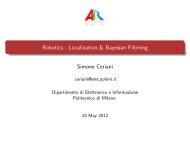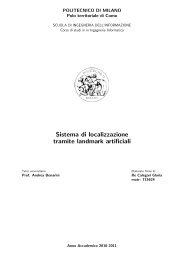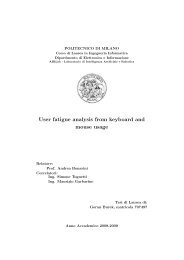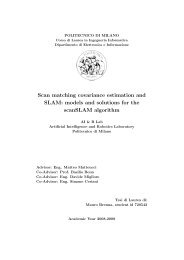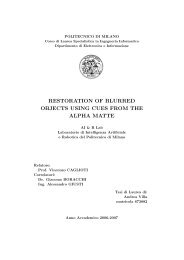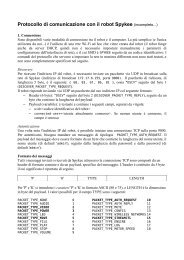Submitted version of the thesis - Airlab, the Artificial Intelligence ...
Submitted version of the thesis - Airlab, the Artificial Intelligence ...
Submitted version of the thesis - Airlab, the Artificial Intelligence ...
You also want an ePaper? Increase the reach of your titles
YUMPU automatically turns print PDFs into web optimized ePapers that Google loves.
2.2. Motion Models 13<br />
2.2 Motion Models<br />
In <strong>the</strong> field <strong>of</strong> robotics <strong>the</strong> topic <strong>of</strong> robot motion has been studied in depth<br />
in <strong>the</strong> past. Robot motion models play an important role in modern robotic<br />
algorithms. The main goal <strong>of</strong> a motion model is to capture <strong>the</strong> relationship<br />
between a control input to <strong>the</strong> robot and a change in <strong>the</strong> robot’s pose.<br />
Good models will capture not only systematic errors, such as a tendency <strong>of</strong><br />
<strong>the</strong> robot to drift left or right when directed to move forward, but will also<br />
capture <strong>the</strong> stochastic nature <strong>of</strong> <strong>the</strong> motion. The same control inputs will<br />
almost never produce <strong>the</strong> same results and <strong>the</strong> effects <strong>of</strong> robot actions are,<br />
<strong>the</strong>refore, best described as distributions [41]. Borenstein et al. [32] cover<br />
a variety <strong>of</strong> drive models, including differential drive, <strong>the</strong> Ackerman drive,<br />
and synchro-drive.<br />
Previous work in robot motion models have included work in automatic<br />
acquisition <strong>of</strong> motion models for mobile robots. Borenstein and Feng [31]<br />
describe a method for calibrating odometry to account for systematic errors.<br />
Roy and Thrun [41] propose a method which is more amenable to<br />
<strong>the</strong> problems <strong>of</strong> localization and SLAM. They treat <strong>the</strong> systematic errors<br />
in turning and movement as independent, and compute <strong>the</strong>se errors for<br />
each time step by comparing <strong>the</strong> odometric readings with <strong>the</strong> pose estimate<br />
given by a localization method. Alternately, instead <strong>of</strong> merely learning two<br />
simple parameters for <strong>the</strong> motion model, Eliazat and Parr [15] seek to use<br />
a more general model which incorporates interdependence between motion<br />
terms, including <strong>the</strong> influence <strong>of</strong> turns on lateral movement, and vice-versa.<br />
Martinelli et al. [16] propose a method to estimate both systematic and<br />
non-systematic odometry error <strong>of</strong> a mobile robot by including <strong>the</strong> parameters<br />
characterizing <strong>the</strong> non-systematic error with <strong>the</strong> state to be estimated.<br />
While <strong>the</strong> majority <strong>of</strong> prior research has focused on formulating <strong>the</strong> pose estimation<br />
problem in <strong>the</strong> Cartesian space. Aidala and Hammel [29], among<br />
o<strong>the</strong>rs, have also explored <strong>the</strong> use <strong>of</strong> modified polar coordinates to solve<br />
<strong>the</strong> relative bearing-only tracking problem. Funiak et al. [40] propose an<br />
over-parameterized <strong>version</strong> <strong>of</strong> <strong>the</strong> polar parameterization for <strong>the</strong> problem<br />
<strong>of</strong> target tracking with unknown camera locations. Djugash et al. [24] fur<strong>the</strong>r<br />
extend this parameterization to deal with range-only measurements<br />
and multimodal distributions and fur<strong>the</strong>r extend this parameterization to<br />
improve <strong>the</strong> accuracy <strong>of</strong> estimating <strong>the</strong> uncertainty in <strong>the</strong> motion ra<strong>the</strong>r<br />
than <strong>the</strong> measurement.




